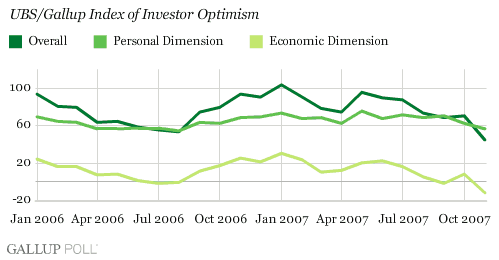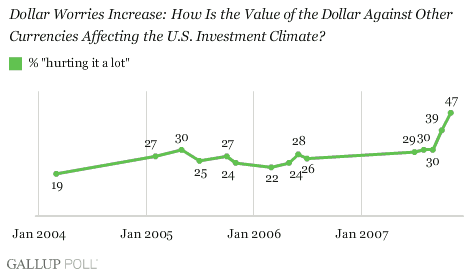PRINCETON, NJ -- Normally, most U.S. investors pay little attention to the value of the dollar and seem to think that no matter what happens to energy prices and housing values, the U.S. consumer will continue spending. All of that may be changing, according to the new UBS/���۴�ýIndex of Investor Optimism poll, conducted in November. Investors have turned pessimistic about the outlook for the U.S. economy over the next 12 months, and overall investor optimism has taken a plunge just as the crucial holiday sales period for the nation's retailers is beginning. This may signal the initial effects of a significant change in U.S. investor/consumer psychology.
Investors Turn Pessimistic About the Economic Outlook
Investor optimism fell sharply in November as the UBS/���۴�ýIndex of Investor Optimism tumbled 26 points; it now stands at 44, or less than half its January level of 103. The Index has declined steadily since May and has now reached its lowest point since September 2005, when it fell to 34 in response to Hurricane Katrina. The Index is conducted monthly and had a baseline score of 124 when it was established in October 1996.
Most of the decline in the overall Index came in its Economic Dimension, which measures investors' feelings about the direction of the overall U.S. economy. It plunged 20 points, from +8 in October to -12 in November, indicating that investors as a group went from being somewhat optimistic in October about the direction of the U.S. economy over the next year to somewhat pessimistic about it in November. Right now, 79% of investors describe the current U.S. economy as being in a slowdown or recession -- the highest percentage since November 2001, when 87% of investors reported feeling this way.
Investors' optimism about their individual investment portfolios also declined, as the Personal Dimension of the Index fell six points in November on top of its eight-point decline in October. It is now at 56 -- its lowest point since August 2006, when it stood at 54.

Worries About the Dollar
Many on Wall Street have been concerned about the declining value of the dollar for some time. Similar concerns have now reached the average investor, as the percentage of investors saying the value of the dollar is hurting the investment climate "a lot" surged to 47% in November. This is the highest level of concern registered about the value of the dollar since monitoring began in March 2004.

A Significant Change in Investor/Consumer Psychology
Sometimes a highly unusual major event takes place, such as Hurricane Katrina, that sends investor and consumer confidence plunging. The impact of this tends to be stunningly sharp in the immediate term but then tends to dissipate fairly quickly. History has shown that there has been a lot of money to be made when contrarian investors buy on these dips in the equity markets. It also has shown that the U.S. consumer has maintained an incredible resiliency in the face of these short-term challenges.
The current decline in investor and consumer optimism is something significantly different. It seems to be the result of a growing number of economic challenges coming together to create what may be a "perfect storm" in terms of investor/consumer psychology. Many Americans are now experiencing a real housing debacle for the first time and thereby seeing that people can actually lose their homes when they become financially overextended. At the same time, they are seeing another surge in energy prices, with oil nearing $100 a barrel and gas prices at the pump surging past the $3-a-gallon mark. Add in all the talk of the dollar reaching new lows against various international currencies, not to mention what seem to be endless worries about the Iraq war and federal budget deficits, and a breaking point in consumer psychology may be approaching.
While many on Wall Street look to another Fed rate cut in December to save both the equity markets and the economy, they might want to step back a minute and ask themselves what it might mean if the U.S. consumer actually becomes more fearful of spending and taking on new debt. This is what happened during the last deep recessions of the 1970s and 1980s.
Survey Methods
Investor results are based on telephone interviews with 804 investors, aged 18 and older, conducted Nov. 1-14, 2007. For results based on the total sample of investors, one can say with 95% confidence that the maximum margin of sampling error is ±4 percentage points.
In addition to sampling error, question wording and practical difficulties in conducting surveys can introduce error or bias into the findings of public opinion polls.
